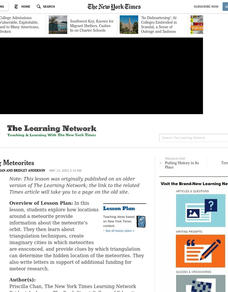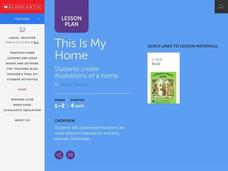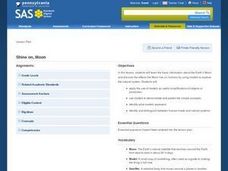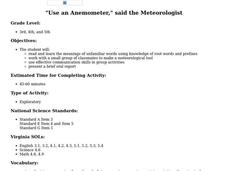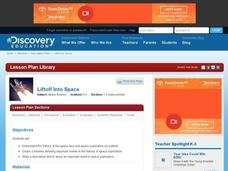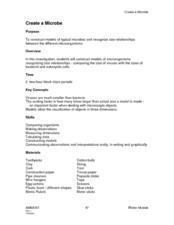K12 Reader
Measuring Temperature
Fahrenheit? Celsius? What's the difference, and where did these two temperature scales originate? Your pupils will learn all about these topics by reading the passage included here. After reading, individuals respond to five questions...
Curated OER
Fossil Fuels (Part I), The Geology of Oil
Junior geologists work through three mini-lessons that familiarize them with the formation and location of fossil fuels. Part one involves reading about petroleum and where it comes from via a thorough set of handouts. A lab activity...
Curated OER
Boa Constrictors
In this expository comprehension worksheet, learners read a 1-page informational article about boa constrictors and then answer 3 short answer and 2 multiple choice questions.
Curated OER
Heating and Cooling a Really Large Lizard
Remind your middle school scientists how fox ear size varies depending on the climate they live in; large ears allow heat loss while small ears keep heat in. Discuss how a cold-blooded animal might try to regulate body temperature. Then...
Curated OER
Arctic Animals: How Do They Measure Up?
Young scientists grab their measuring tapes, rulers, and yard sticks as they see how big Arctic animals really are. To conceptualize the trait of height or length, each small group will measure out the entire length of an arctic animal....
Curated OER
Mapping Meteorites
After reading an article, "Cameras Capture a 5-Second Fireball and Its Meteorite's Secrets," space science superstars use the triangulation method to determine the location of a distant object. In-class activities and homework are...
Curated OER
Seed to Plant
Students understand the stages of a plants life. For this stages of plant development lesson, students read about bean plants and grow their own. Students record growth and photograph changes in their plants. Students label the parts of...
Curated OER
This Is My Home
Students listen to a read aloud of Mary Ann Hoberman's A House Is a House for Me before discussing the meaning of habitats and the different types of homes that people live in. Next, they pretend to be architects and design a home for...
Curated OER
"Use an Anemometer," said the Meteorologist
Students participate in an hands-on construction of an instrument to measure wind speed.
Curated OER
Reaction Time
Students investigate their reaction times for grabbing a dropped ruler after discussing reactions times to other events such as moving your foot from the gas pedal to the brake. They drop the ruler from a sent height and record the time...
Curated OER
Finding Your Center of Gravity: Science, Math, Measurement, Math
Students use bathroom scales, rulers and boards to explore how to measure their own center of gravity.
Curated OER
Monster Sunspots!
In this sunspots worksheet, students read about the large sunspots observed for thousands of years and their indication of solar storms. Students use given images to find the scales and physical sizes of the 3 sunspots shown.
Curated OER
Shine On, Moon
Pupils explore space science by conducting an experiment in class. In this Moon lesson, students define a list of space science vocabulary and read the book The Moon. Pupils utilize shoeboxes and string to conduct a sunlight experiment...
Curated OER
"Use an Anemometer," said the Meteorologist
Students work in groups to make an instrument the Meteorologists use to measure the speed of the wind after the teacher reads them a poem about the wind. Students then review vocabulary that they studied from their lesson.
Curated OER
Weather Records
Learners write newspaper articles based on weather records set around the world. Students read and discuss weather records and their results, then write a newspaper article about how the weather records have affected people around the...
Curated OER
Fun With Rainfall Measurements
Demonstrate how rain is measured. Pupils will use a rain gauge to measure the amount of rainfall during one week. Then record the data and discuss the results.
Alabama Learning Exchange
Straight Line Motion
Students examine gravity, mass, and friction. In this speed and motion instructional activity, students investigate how straight line motion is impacted by gravity, mass, and fiction as they participate in a hands-on activity.
Curated OER
Tracing Highs and Lows in San Francisco
On a topographic map, students identify the scale bar, north arrow, and contour interval. They then locate a hill on the map and make note of the contour lines. Students then locate other places with similar contour line patterns....
Curated OER
Liftoff Into Space
Students explore the history of space exploration. For this history of space exploration lesson, students create a timeline of space exploration. Students watch a space video and discuss important events. Students research space...
Curated OER
Would You Believe Your Eyes?
Students study the parts and functions of the human eye. They create dodecagons which are twelve-sided figures with twelve equal angles and share these with the class so that each student can begin to see how many different illusions can...
Curated OER
Create a Microbe
Students construct models of microorganisms recognizing size relationships-comparing the size of viruses with the sizes of bacterial and eukaryotic cells. They put into perspective just how small microbes are by comparing the size of...
Curated OER
Measuring Rainfall
Students investigate the amount of rain that falls in their area through the construction and monitoring of a rain gauge. The gauge is observed for one week, recordings are made, and observations described in a chart.
Curated OER
You Can Take the Pressure!
Middle schoolers construct and use a barometer over a period of 1-2 weeks to investigate and predict upcoming weather from barometric pressure.
Curated OER
Neat Feet
Students view a video and discuss different kinds of feet found in the animal kingdom. They make prints using paint, rubber stamps and their own feet and then measure and compare the tracks.





